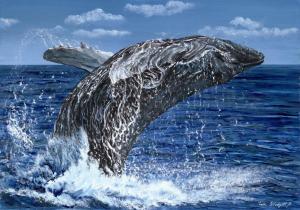Sale on canvas prints! Use code ABCXYZ at checkout for a special discount!

Growth does not have to come at the expense of the environment and its inhabitants. In fact, nature's forms inspire new technology, spark new economies, and we have only just begun to account for the importance biodiversity plays in maintaining the health of the ecosystems which support us. Each month we highlight one organism's contribution to the ecosystems. By understanding the impact that just one organism has on these natural processes, we hope can help you understand that no organism is dispensable in this delicate and precarious biosphere we all share.
Beauty In The Beast
The Humpback Whale's scientific name means big-winged New Englander. And fly they do, breaching into our world in spectacular fashion. They are very much like us, possessing the same types of neuron cells. Every year male humpback whales compose a complex, thirty minute song, the theme of which varies from year to year. But in many ways whales are better. Their hearing is twenty times as sensitive as ours.
In life and death, whales serve a tremendous role in supporting the ecosystems of the ocean. In places where they have disappeared from the oceans, killer whales have been forced to find alternate food sources, resulting in a vast decline in the number of sea lions, sea otters and seals. A single whale carcass supports small cities of scavenger species on the sea floor, sometimes for up to a year. The offal (entrails and internal organs) are particularly important to algae and phytoplankton growth.
The research of conservation biologist Joe Roman has shown that by "diving for energy-rich crustaceans, then rising from the depths to breathe...transfer thousands so tons of nitrogen to the surface (through their feces) in areas where they feed: they are, in a sense, fertilizing their own garden, bringing more nitrogen into the gulf (of Maine) than all the rivers in the region combined."[i]
Causes for Concern
It's estimated that hunting decimated 90% of the population of humpback whales until the public took notice. While populations have rebounded, whales and other predators are still hunted by Japanese whaling boats as the government views them as competition for fisheries.
Seismic mapping, sonar, and shipping traffic may be confusing the sensitive hearing capabilities of whales, and hindering their ability to communicate. To compensate, they have increased the duration of their calls.
Humpback whales feed on swarms of krill. But pollution in the ocean destroys the plankton on which the krill feed. The unsustainable waste outputs of our consumption patterns have found their way into not just the ocean, as revealed in its rising temperatures, acidity, and visible trash heaps, but also in whale bodies themselves. Ingestion of plastic is an increasing cause of death for many marine creatures, including whales.
PCBs (chemicals in industrial process and electrical transformers) and DDT (synthetic pesticides) build up in such high concentrations that in some instances the bodies of dead bodies are considered hazardous waste, such as with Belugas in the St. Lawrence River in Quebec.
Collisions with ships are also still a threat. The initiative of whale biologist Dave Wiley to bring his data directly to the shipping companies resulted in a successful agreement to shift shipping routes as they approach Boston Harbor.
Ways You Can Help
Show your support for organizations such as "The Sea Shepherd Conservation Society", who is on the front lines to protect such whales as the blue whale from commercial fishing, and hopefully shift sentiment in cultures that consume these animals at unsustainable rates. Other organizations to look into are "Save the Whales" or the "Whale and Dolphin Conservation Society".
If you enjoy fishing, never dispose of used fishing lines and hooks in the water, as this can entangle and kill marine life.
At home, reducing your use of plastic of all kinds would be a good start. Opt instead for materials that are more readily biodegradable.
Even proper maintenance of your car is another way to prevent dissemination of hazardous waste, and leaks that can cause water pollution. Paints, pesticides, and antifreeze should be brought to hazardous waste sites if they must be used.
--------------------------------------------------------------------------------
[i] Roman, Joe, "Why Whales? On learning from nature and the Endangered Species Act", Harvard Magazine, May-June 2011